CPC Definition - Subclass B62M
This place covers:
Rider propulsion of wheeled vehicles, e.g. cycles having two or more wheels, using essentially the mechanical energy of the rider, e.g. by hand or feet, to propel the vehicle.
Rider propulsion of wheeled vehicles as above with additional source of power, e.g. combustion engines or electric motors, said additional source of power might be used in addition according the need of the rider.
Propulsion devices for sledges or the like, e.g. snow vehicles with or without engine, cycles having an endless tracks rather than wheels, motor powered sledges.
Vehicles, e.g. motorcycles, characterised by position of motor or engine with respect to vehicle frame, wheels or other components. Motorcycle aspects in relation to support or mounting of engine or motor, the exhaust system, cooling system, mufflers, air intake or the arrangements of accessories.
Transmission aspects characterised by the use of an endless flexible members, e.g. chains, inter-engaging toothed wheels, or frictionally engaging wheels or friction rollers engaging the periphery of a ground wheel.
Transmission characterised by rotary shafts, e.g. cardan shafts, or non-mechanical gearing, e.g. fluid gearing.
Transmission for hybrid motorcycles, e.g. having an electric motor and a internal combustion engine.
Pedals or cranks
Actuators for speed change mechanisms specially adapted for cycles.
There are significant overlapping between subclasses B62M and B62K, the latter dealing more with the cycles frame aspects. In practical most of the documents classified for example in B62M 25/00 (actuators for gear shifting) are also classified in B62K 23/00 (Rider operated controls specially adapted for cycles). Similarly motorcycles in main group B62M 7/00 characterised by position of motor or engine have a strong relationship with main group B62K 11/00 dealing with frames for motorcycles, engine assisted cycles or motor scooters.
This place does not cover:
Wheelchairs | |
Footrests | |
Power driven cycles with four or more wheels | |
Power driven tricycles | |
Adaptation of engines for driving cycles |
Attention is drawn to the following places, which may be of interest for search:
Shoes for cyclist | |
Ski or snowboards | |
Skateboards | |
Tools for cycles | |
Cycles hubs rotatable arranged on an axle | |
Arrangement or mounting of transmission in vehicles | |
Propulsion of electrically propelled vehicles | |
Sledges with runners | |
Electric or power supply devices relating to lightening | |
Cycle chain guards | |
Bicycles without a seat, e.g. non-motorised scooters | |
Motorcycles, engine assisted cycles or motor scooters | |
Handle bar grips | |
Twist grips, levers for rider operated controls | |
Levers or grips especially adapted for brake mechanism | |
Gas-flow silencers or exhausts apparatus for ICE | |
Kick-starter mechanism or the like | |
Means for transmitting movement in a flexible sheathing,e.g.Bowden mechanism | |
Gearings per se |
Where applicable, additional classification should be given in the following codes:
B62K 2202/00 Motorised scooters
B62K 2204/00 Adaptations for driving cycles by electric motor (for driving electrically assisted bicycles B62M 6/00)
Additional classification should also to be given in the codes associated with main groups B62M 3/00, B62M 7/00, B62M 9/00, B62M 9/124, B62M 25/00 and B62M 27/02
In this place, the following terms or expressions are used with the meaning indicated:
Transmissions | The term transmission means all parts between the prime mover or the part to which a rider immediately applies propulsion effort, e.g. pedal cranks, and a driven ground wheel. |
This place covers:
Rider propulsions of wheeled vehicles, e.g. bicycles, using essentially the mechanical energy of the rider, e.g. by hand or feet, to propel the vehicle.
Involving devices which enable occasionally the storing and releasing of rider energy, e.g. arrangement of flywheels
This place does not cover:
Construction of cranks operated by hand or foot of adjustable lenght | |
Cranks which can be immobilised as foot rests | |
Rider propulsion of wheeled vehicles with additional source of power | |
Ground-engaging propulsion device for cycles | |
Wheelchairs | |
Cycles, e.g. scooters, propelled only by rider pushing his foot on the floor |
This place covers:
Rider propulsions of wheeled vehicles, e.g. bicycles, having pedals connected to crank shaft by means of reciprocating levers, wherein one end of the lever is connected to the pedal and the other end to the crank shaft. The rider propels the vehicles by pressing on the pedals alternatively in two direction.
This place does not cover:
Cranks which can be immobilised as foot rests |
This place covers:
Rider propulsion using pedals following essentially a reciprocating movement. The reciprocating levers are combined with the rotary crank mechanism, wherein usually one end of the lever is connected to the pedal, and the other end of the lever is linked to the rotary crank.
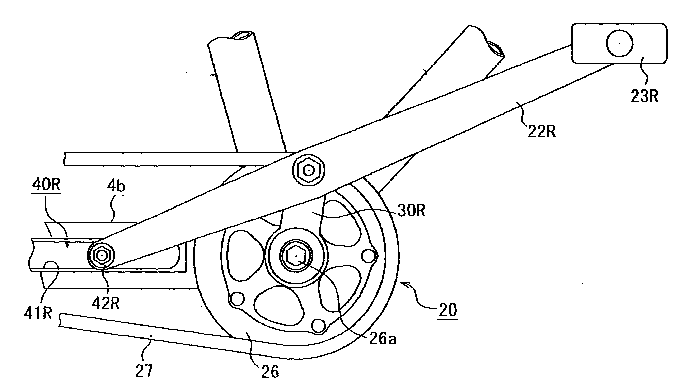
This place covers:
Rider propulsion using pedals following essentially a reciprocating movement and being connected to the crank shaft or driven wheel by flexible members, e.g. chains, belt or cables.
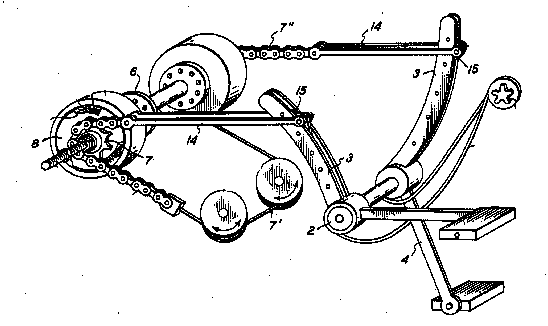
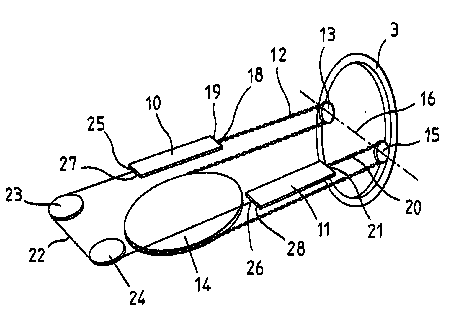
This place covers:
Rider propulsion using pedals following essentially a reciprocating movement and connected to the crank shaft or driven wheel by using intermediate toothed wheels, e.g. for speed reduction.
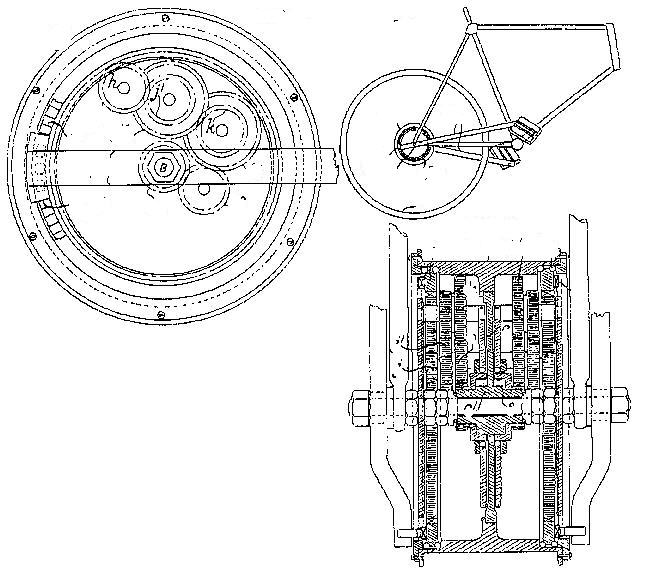
This place covers:
Rider propulsion using pedals following essentially a reciprocating movement. The levers having a first end connected to the pedal and the second end directly connected to the driven wheel axle. The driving connection could use a ratchet wheel.
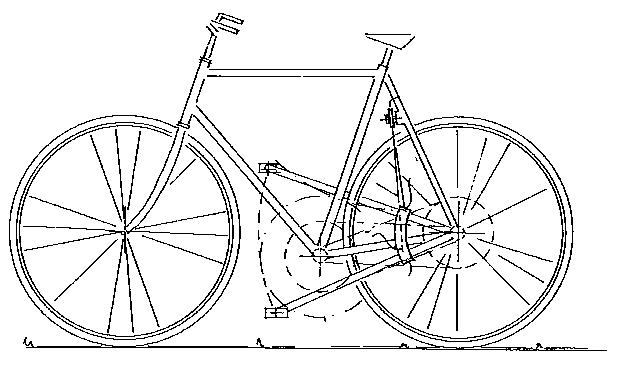
This place covers:
Rider propulsion of wheeled vehicle where the rider propels the vehicle by walking on an endless belt or the like.
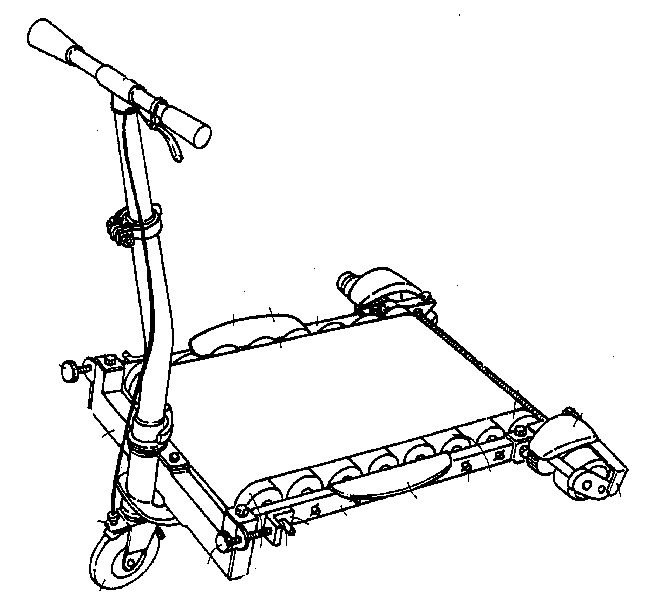
This place covers:
Rider propulsions having rotary cranks with pedals attached to the end of the crank arms.
This place covers:
The crank levers are directly arranged on the driven axle, a freewheel could be used to uncouple the crank when driving down on a slope.
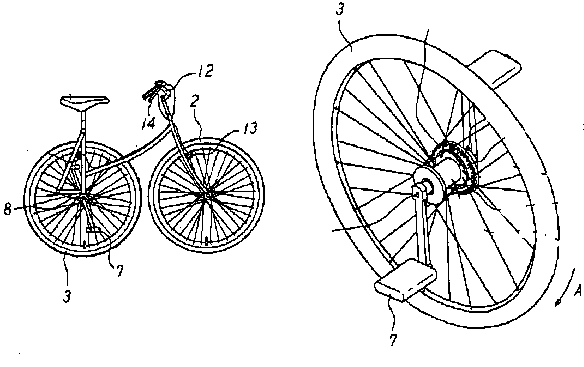
This place covers:
Cycle cranks, crank axle and bearings, hand cranks, pedals, toe-clip, cleat and accessories
Arrangement of cranks to facilitate rider propulsion, e.g. cranks of adjustable length.
This place does not cover:
Attention is drawn to the following places, which may be of interest for search:
Shoes for cyclist | |
Frame parts shaped to receive bottom brackets |
This place covers:
The arrangement of footrest device for use on two-wheeled engine driven vehicles and bicycles, commonly known as "moped", and represents a combination footrest and pedal.
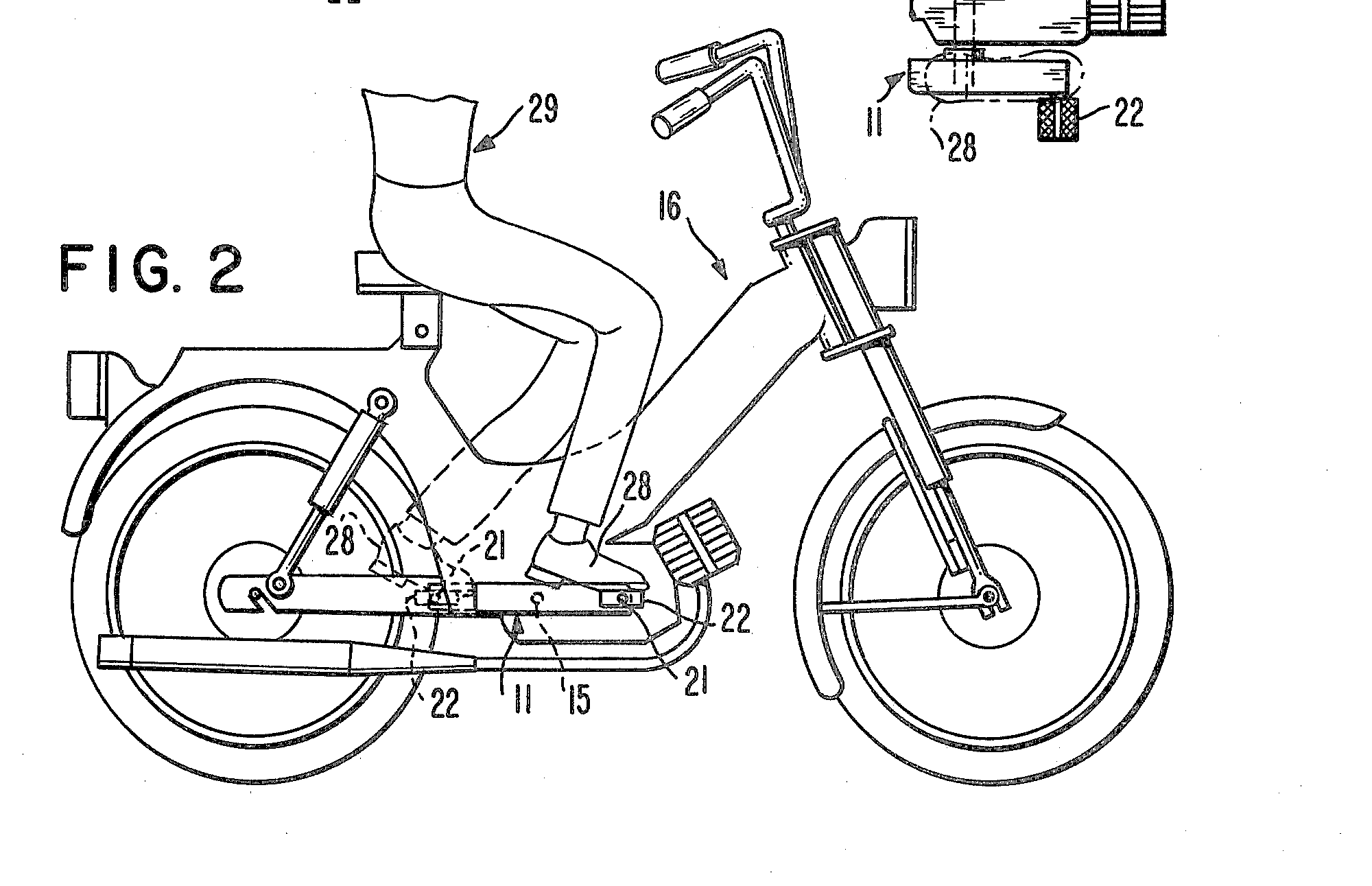
Attention is drawn to the following places, which may be of interest for search:
Rider propulsion of wheeled vehicle with reciprocating levers | |
Rider propulsion of wheeled vehicles with additional source of power | |
Immobilising against theft | |
Foot-rest |
This place covers:
Rider propelled cycles, e.g. bicycles, tricycles having additional source of power
Subject-matter related to the use of additional source of power in rider propelled cycles.
Rider propelled cycle with additional source of propulsion power different from combustion engine or electric motor.
Attention is drawn to the following places, which may be of interest for search:
Motorcycle characterized by position of motor or engine | |
Bicycle or tricycle having the additional source of power on a auxiliary wheel unit | |
Transmission characterized by use of friction roller engaging the periphery of the ground wheel | |
Transmission characterized by two or more dissimilar sources of power, e.g. transmission for hybrid cycles | |
Wheelchairs | |
Electric or power supply devices relating to the cycle power supply for lightening | |
Cycles with more than two road wheels, e.g. tricycles | |
Features relating to engine or motor driven bicycles, e.g. frames, steering wheel forks or handle-bar constructions associated therewith |
In this main group, at each hierarchical level, in the absence of an indication to the contrary, classification is made in the first appropriate place.
This place covers:
Bicycle having a combustion engine as an additional source of power in order to propel the vehicle when requested by the rider.
This place covers:
Means, specially adapted for the application on bicycle, for controlling the delivery of power to the cycle by first "sensing or detecting" of parameters, e.g. rider pedaling force, torque, speed or braking force and then sending a signal to the engine in order to control the combustion engine output torque to the cycle. Arrangement of sensors or detectors on the cycle.
Attention is drawn to the following places, which may be of interest for search:
Controlling combustion engine |
This place covers:
Cycles where the power output of the combustion engine is transmitted to the pedal crank shaft through a power transmission arrangement at the pedal crank shaft and which together with the pedal crank arrangement permit the bicycle to be readily operated in the engine power mode or pedal power mode.
This place covers:
Cycles where the power output of the combustion engine is transmitted to the rear wheel axle shaft through a power transmission arrangement at the wheel axle shaft. The engine driving shaft might be coaxial with the driven wheel axle shaft.
This place covers:
Cycles where the power output of the combustion engine is transmitted to the flexible member which connects the rear wheel axle shaft to the pedal shaft. . The flexible member might be a chain, belt or the like and can be driven either by the engine or by the pedal-driven chain wheel or pulley. In general the power transmission arrangement includes also reduction gears.
This place covers:
Cycles where the power output of the combustion engine might be transmitted to the ground or road wheel through a power transmission arrangement which includes friction or pressure rollers or the like. The rollers might be set in contact with the periphery or the side of the ground wheel.
Attention is drawn to the following places, which may be of interest for search:
Transmission characterized by the use of friction roller or gears engaging the ground wheel having only human propulsion |
This place covers:
Cycle having an electric motor as additional source of power in order to propel the vehicle when requested by the rider. The electrical motor is in general fed by battery, solar power or fuel cells.
This place covers:
Means, specially adapted for the application on bicycle, for controlling the delivery of power to the cycle by sensing or detecting of parameters, e.g. rider pedaling force, torque, speed or braking force and then sending a signal to the motor in order to control the output torque to the cycle. This subgroup deals with the way power is diverted or switched over from the motor to the cycle when requested by the rider or automatically according the circumstances or the detected parameters.
Attention is drawn to the following places, which may be of interest for search:
Propulsion of electrically-propelled vehicles; Control therefor |
This place covers:
Sensing devices or detectors specially adapted for the application on the cycle for sensing or detecting control parameters, e.g. rider pedaling force, torque, speed or braking force. In particular the arrangement or the specific location on the cycle.
This place covers:
Cycles where the power output of the electric motor is transmitted to the pedal crank shaft through a power transmission arrangement at the pedal crank shaft and which together with the pedal crank arrangement permit the bicycle to be readily operated in the motor power mode or pedal power mode.
This place covers:
Cycles where the power output of the electric motor is transmitted to the rear wheel axle shaft through a power transmission arrangement at the wheel axle shaft. The electric motor shaft might be connected to the wheel axle shaft through chain, belt or gear transmissions.
This place covers:
Cycles where the power output of the electric motor is transmitted to the rear wheel axle shaft through a power transmission arrangement at the wheel axle shaft. The motor driving shaft is coaxial with the driven wheel axle shaft.
This place covers:
Cycles where the power output of the electric motor is transmitted to the flexible member which connects the rear wheel axle shaft to the pedal shaft. The flexible member might be a chain, belt or the like and can be driven either by the motor or by the pedal-driven chain wheel or pulley. In general the power transmission arrangement includes also reduction gears.
This place covers:
Cycle where the power output of the electric motor might be transmitted to the ground or road wheel through a power transmission arrangement which includes friction or pressure rollers or the like. The rollers might be set in contact with the periphery or the side of the ground wheel.
Attention is drawn to the following places, which may be of interest for search:
Transmission characterized by the use of friction roller or gears engaging the ground wheel having only human propulsion |
This place covers:
Auxiliary equipment or accessories, e.g. batteries or fuel cells feeding the electric motor. Devices having special features to be considered specially adapted for the application on a power assisted cycle, e.g. cooling system specially adapted for the auxiliary electric motor. Furthermore this sub-group also deals with the location and the arrangement of the accessories on the cycle.
This place covers:
Solar cells on cycles providing a power source to batteries or electric propulsion motors. Arrangement of solar cells on the cycle.
This place covers:
Batteries on cycles providing a power source for electric propulsion motors. Arrangement of these batteries on the cycle.
Attention is drawn to the following places, which may be of interest for search:
Electric or power supply devices relating to the cycle power supply for lightening |
This place covers:
Two wheel motorized vehicle, e.g. having electric motor or internal combustion engine. The different sub-groups are to be selected in accordance with the position of the motor or engine with respect to vehicle parts or components, e.g. B62M 7/02 with engine between front and rear wheel.
Each sub-groups covers motorcycle aspects such as, e.g. engine or motor support and mounting thereof, exhaust system, cooling system, mufflers, air intake, accessories and arrangement thereof, e.g. batteries.
In this respect, attention is also drawn to correspondent groups and sub-groups concerning frame details B62K 11/00.
This place does not cover:
Rider propulsion of wheeled vehicles with additional source of power, e.g. auxiliary combustion engine or electric motor | |
Transmission characterised by the use of two or more dissimilar sources of power, e.g. hybrid motorcycles |
Attention is drawn to the following places, which may be of interest for search:
Arrangement or mounting of electrical propulsion units | |
Frames of motor-cycles, engine-assisted cycles or motor-scooters and related position of engine | |
Adaptation of engines for driving cycles |
This place covers:
Transmission for cycles with or without engine where emphasis is placed on the flexible element, e.g. transmitting the drive from the drive to the driven component, e.g. sprocket or gear wheel. More importantly on the way the flexible element is shift or tensioned.
Attention is drawn to the following places, which may be of interest for search:
Cycles characterized by position of engine | |
Transmissions characterized by the use of inter-engaging toothed wheels or frictionally-engaged wheels | |
Cycle hubs rotatable arranged on axle | |
Cycle chain guards |
This place covers:
Devices for lateral shifting of cycle chains not specific for the rear or front cluster sprockets
Accessories for cycle derailleurs not specific for the rear or front clusters
This place covers:
Devices for shifting the chain laterally on the cycle cluster sprockets situated at the rear wheel of a cycle or similar vehicle.
This place covers:
Electric or fluid assisted rear derailleur and control methods therefore for shifting chains by rear derailleur. Contrary to the directly manual actuated derailleur, these shifting devices are assisted by a small electric or fluid operated servos connected to the derailleur mechanism.
Attention is drawn to the following places, which may be of interest for search:
Actuators for gearing speed-change mechanisms specially adapted for cycles with electrical or fluid transmitting systems |
This place covers:
Rear derailleurs having the chain moved laterally without rider intervention. The chain guide movement is controlled automatically in accordance with pre-set parameters, e.g. the crank speed or the pressure on the pedals.
This place covers:
Rear derailleurs comprising all or most of the following features: a fixed member connected to the bicycle frame, a base member, a linkage mechanism, a movable member and chain guides, cable receiving and connecting portions, springs or the like devices. The linkage mechanism insures proper lateral shift movement of the chain over the different rear sprockets by acting on the chain guide. The mechanism can comprise articulated linkages, plates, cams or telescopic shafts.
This place covers:
Details of the linkage mechanism, e.g. articulated parallelograms or quadrilateral systems, connecting the base member to the chain guide in order to move the chain guide laterally relative to the base member. In general the linkage mechanism also comprises a cable fixing portion.
This place covers:
Means, e.g. stops, projections, detents or the like, for improving positioning of the mechanism or for limiting the movement of the mechanism to avoid shocks against the bicycle frame.
This place covers:
Means using cams or plates for limiting or positioning the shifting mechanism
This place covers:
The arrangement, the location and the functioning of the biasing means in relation with the shifting mechanism. Given that all the shifting mechanism in general discloses biasing or spring means, this sub-group is meant to be used for those shifting mechanism in which a particular emphasis is placed on the arrangement of the biasing means of the shifting mechanism, the particular form of these biasing means or on special effects expected by these means.
This place covers:
Mounting or arrangement of the rear derailleur onto the bicycle frame.
Attention is drawn to the following places, which may be of interest for search:
Frame part to receive other cycle parts or accessories |
This place covers:
Chain guide components and characteristic features thereof; mounting of the chain guide on the movable member. The chain guide in general comprises a pair of cage plates and two chain pulleys rotationally supported between the cage plates. The movable member connects the chain guide to the linkage mechanism.
Attention is drawn to the following places, which may be of interest for search:
Tensioning or adjusting equipment for chains, belts or the like |
This place covers:
Means specially adapted for use on a rear derailleur for receiving, guiding or mounting cables in order to facilitate the smooth operation of the derailleur and the cable. These means could be for example cable pulleys, sleeves, special grooves or projections.
Attention is drawn to the following places, which may be of interest for search:
Actuators for gearing speed change mechanism specially adapted for bicycles with mechanical transmitting systems e.g. levers, cables | |
Means for transmitting linear movement in a flexible sheathing, e.g. "Bowden-mechanisms" |
This place covers:
Devices which are not forming actual part of the derailleur but are for use with the derailleur for a particular purpose, e.g. the protection of the rear derailleur
This place covers:
Devices for shifting the chain laterally on the cycle cluster sprockets situated close to the pedal crank of a cycle or similar vehicle.
This place covers:
Electric or fluid assisted front derailleurs and control methods therefor for shifting chains by front derailleurs. Contrary to the directly manual actuated derailleur, these shifting devices are assisted by a small electric or fluid operated servos connected to the derailleur mechanism.
Attention is drawn to the following places, which may be of interest for search:
Actuators for gearing speed-change mechanisms specially adapted for cycles with electrical or fluid transmitting systems |
This place covers:
Front derailleurs having the chain moved laterally without rider intervention. The chain guide movement is controlled automatically in accordance with pre-set parameters, e.g. the crank speed or the pressure on the pedals.
This place covers:
Front derailleurs comprising all or most of the following features: a fixed member connected to the bicycle frame, a base member, a linkage mechanism, a movable member and chain guides, cable receiving and connecting portions, springs or the like devices. The linkage mechanism insures proper lateral shift movement of the chain over the different rear sprockets by acting on the chain guide. The mechanism can comprise articulated linkages, plates, cams or telescopic shafts.
This place covers:
Details of the linkage mechanism, e.g. articulated parallelograms or quadrilateral systems, connecting the base member to the chain guide in order to move the chain guide laterally relative to the base member. In general the linkage mechanism also comprises a cable fixing portion.
This place covers:
Means, e.g. stops, projections, detents or the like, for improving positioning of the mechanism or for limiting the movement of the mechanism to avoid shocks against the bicycle frame.
This place covers:
Means using cams or plates for limiting or positioning the shifting mechanism
This place covers:
The arrangement, the location and the functioning of the biasing means in relation with the shifting mechanism. Given that all the shifting mechanism in general discloses biasing or spring means, this sub-group is meant to be used for those shifting mechanism in which a particular emphasis is placed on the arrangement of the biasing means of the shifting mechanism, the particular form of these biasing means or on special effects expected by these means.
This place covers:
Mounting or arrangement of the rear derailleur onto the bicycle frame.
Attention is drawn to the following places, which may be of interest for search:
Frame part to receive other cycle parts or accessories |
This place covers:
Chain guide components and characteristic features thereof; mounting of the chain guide on the movable member. The chain guide comprises, in general, a pair of cage plates and two chain pulleys rotationally supported between the cage plates. The movable member connects the chain guide to the linkage mechanism.
Attention is drawn to the following places, which may be of interest for search:
Tensioning or adjusting equipment for chains, belts or the like |
This place covers:
Means specially adapted for use on a front derailleur for receiving, guiding or mounting cables in order to facilitate the smooth operation of the derailleur and the cable. These means could be for example cable pulleys, sleeves, special grooves or projections.
Attention is drawn to the following places, which may be of interest for search:
Actuators for gearing speed change mechanism specially adapted for bicycles with mechanical transmitting systems e.g. levers, cables | |
Means for transmitting linear movement in a flexible sheathing, e.g. "Bowden-mechanisms" |
This place covers:
Devices which are not forming actual part of the derailleur but are for use with the derailleur for a particular purpose, e.g. the protection of the front derailleur
This place covers:
Transmission for two wheels vehicles, or equivalent, with unchangeable and changeable ratio working with spur gear wheels, bevel gear wheels, frictionally engaging wheels or planetary gears. Groups and subgroups relating to the way the vehicle is propelled such as B62M 1/00, B62M 6/00 take precedence.
Two examples of such transmissions using bevel gears (B62M 11/10) are represented in the following figures from FR2753431 and US6446995. The US document is also classified in B62M 17/00 for the cardan shaft aspects.
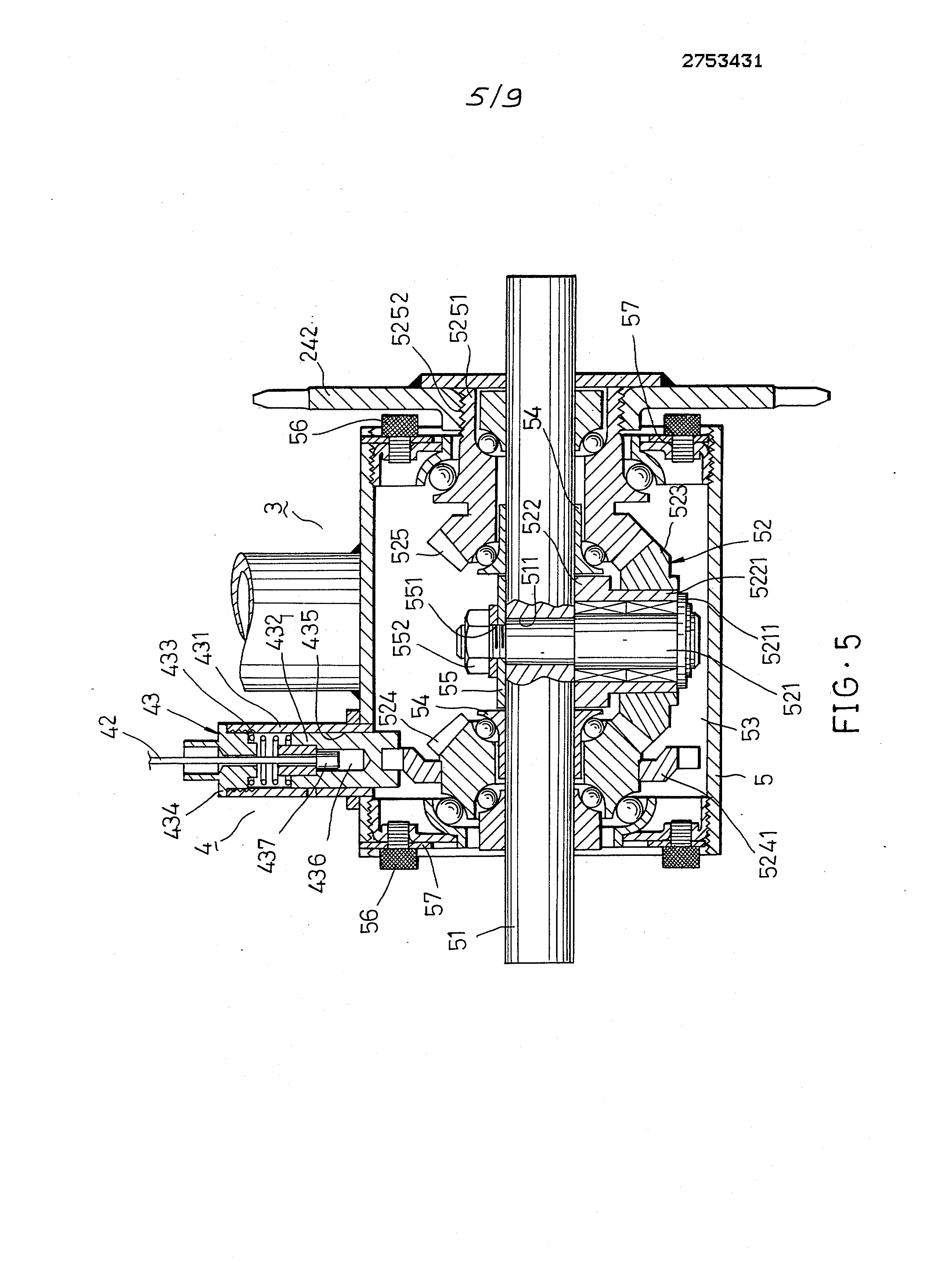
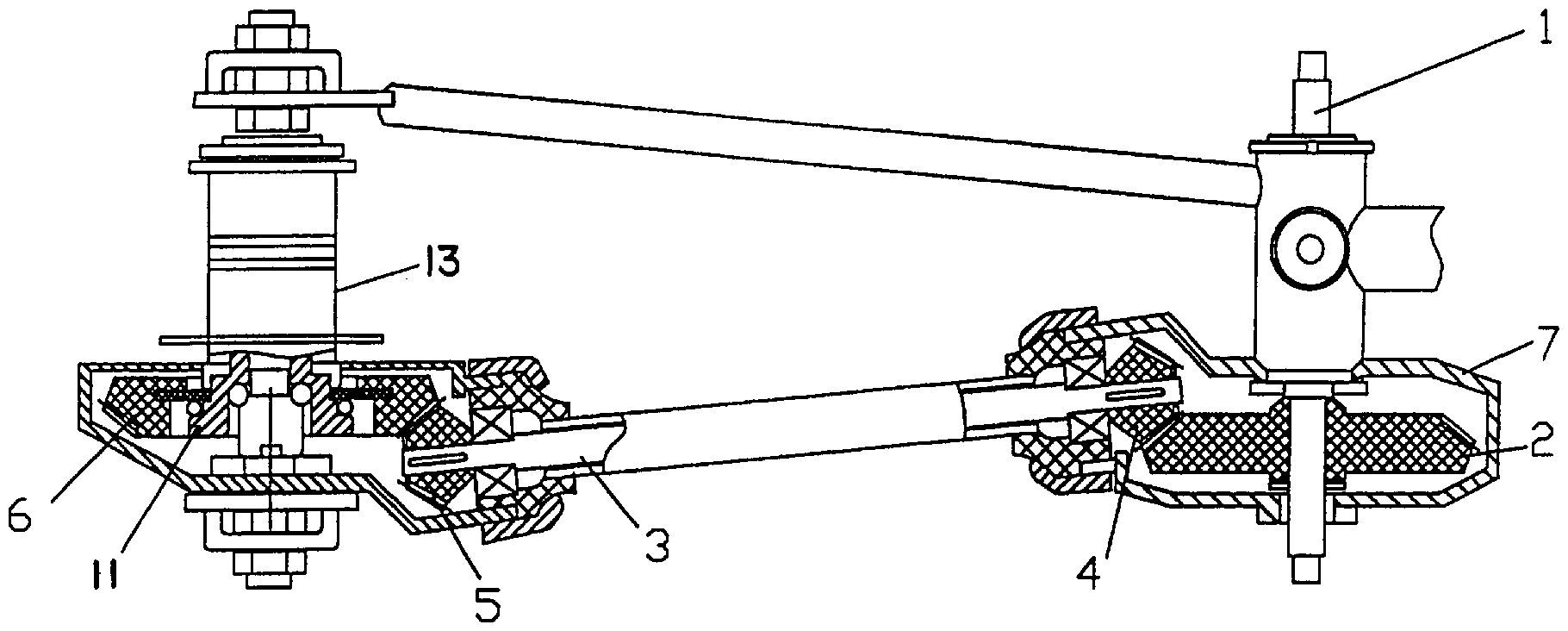 US6446995
US6446995
This place does not cover:
Rider propulsion of wheeled vehicles with reciprocating levers characterised by the use of interengaging gears | |
Rider propulsion of wheeled vehicles with additional source of power | |
Transmission characterised by the use of friction rollers engaging the periphery of a ground wheel |
This place covers:
Devices operated by the rider, e.g. muscle driven, such as friction rollers, toothed gears, belts or the like engaging the periphery or rim of the ground wheel. An example is given in the following figure. Similar devices driven by motor should be classified in B62M 6/75.
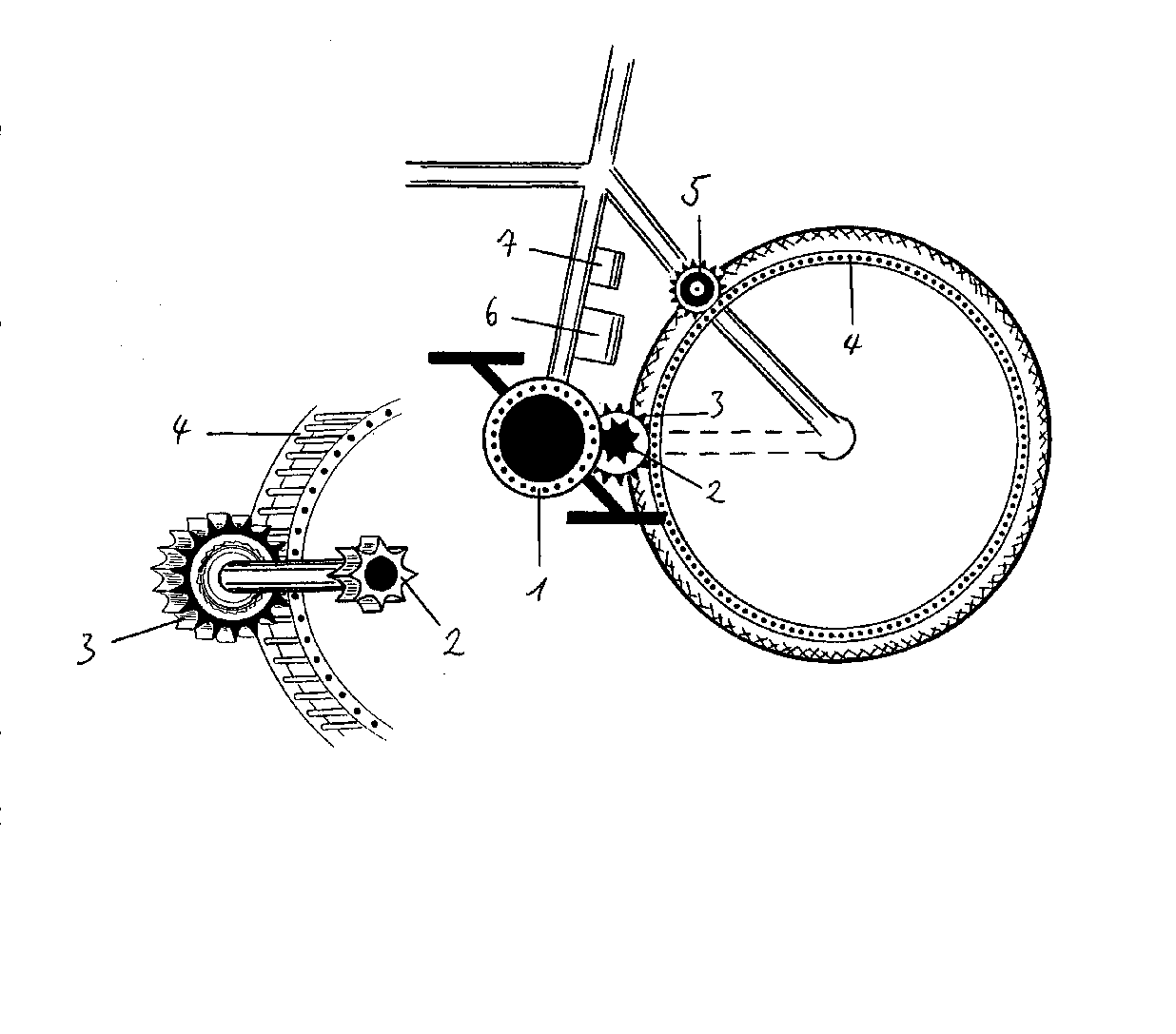
This place covers:
Transmissions having the cycle crank shaft and the driven shaft connected by rods, as in the figure below.
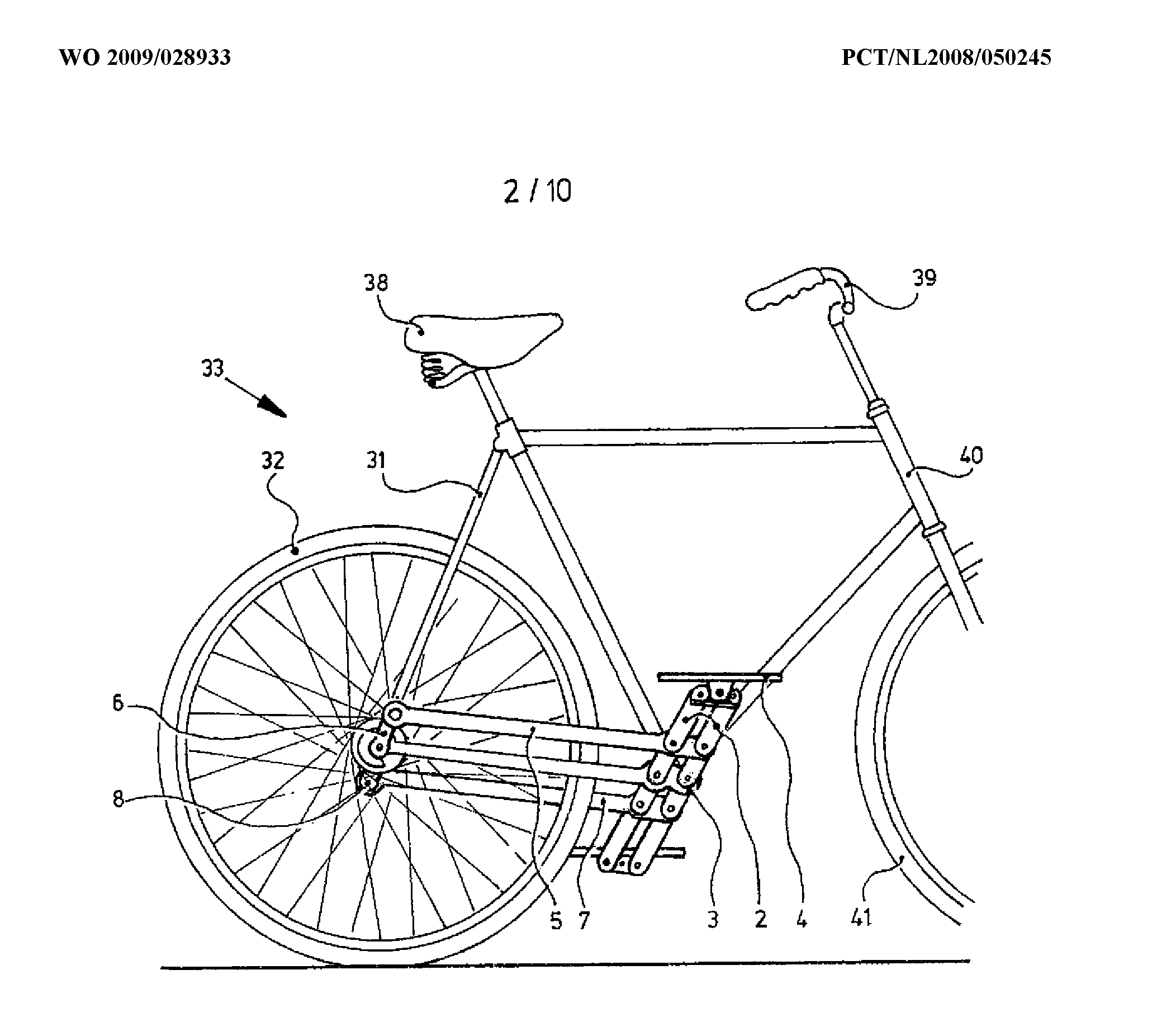
Attention is drawn to the following places, which may be of interest for search:
Rider propulsion of wheeled vehicles |
This place covers:
Cycle transmissions using a rotary shaft to transmit the drive from the driving shaft to the driven shaft.

Attention is drawn to the following places, which may be of interest for search:
Rider propulsion of wheeled vehicles | |
Rider propulsion of wheeled vehcle with addition source of power | |
Transmission characterised by the use of inter-engaging toothed wheels | |
Arrangement or mounting of transmission in vehicles characterised by arrangement, location, or type of main drive shafting, e.g. cardan shaft | |
Gearing per se |
This place covers:
Cycle using fluid trasmitting means, e.g. gas or oil to transmit the drive from the driving shaft to the driven shaft. as in the figure below.

This place does not cover:
Actuator for gearing speed-change specially adapted for cycles with electrical or fluid transmitting systems |
This place covers:
Cycles transmission using resilient element such as, e.g. spring or similar element within th etransmission itself.
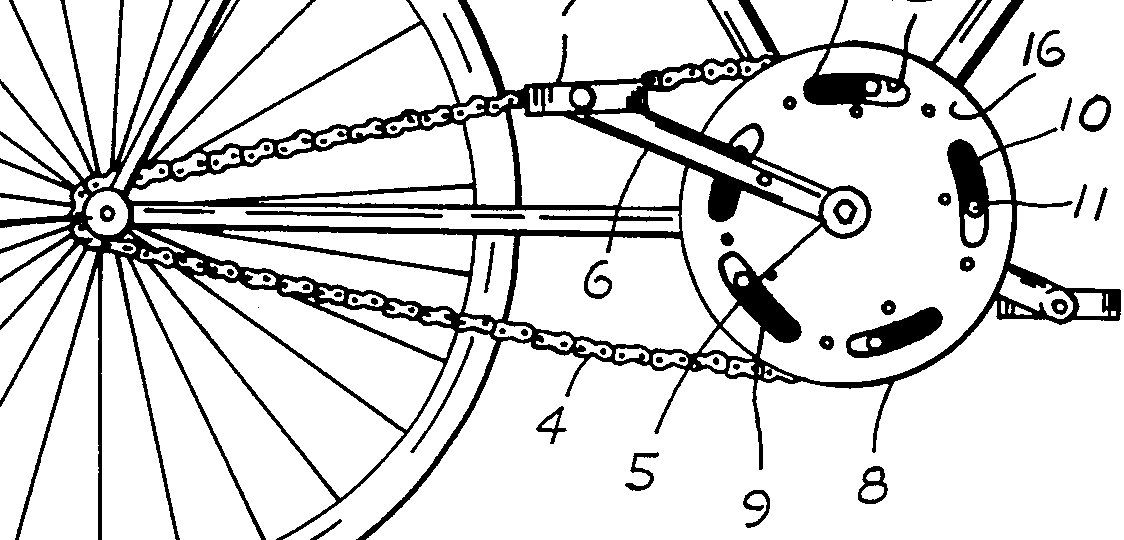
Attention is drawn to the following places, which may be of interest for search:
Rider propulsion of wheeled vehicles involving devices which enable the mechanical storing and releasing of energy occasionally using elestic element |
This place covers:
Transmissions arrangement where the driving is transmitted to both front and rear wheel, e.g. all wheel drive cycle. The group includes transmission arrangements with or without motor or engine.
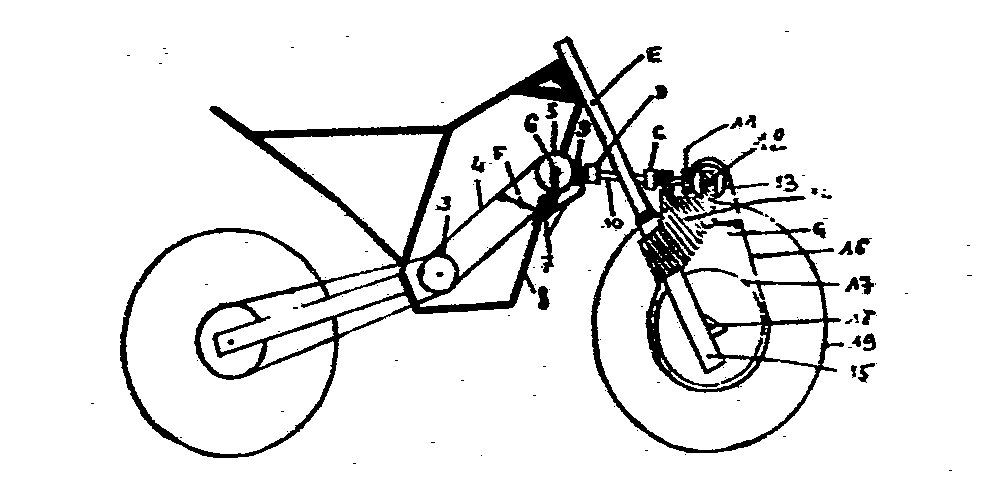
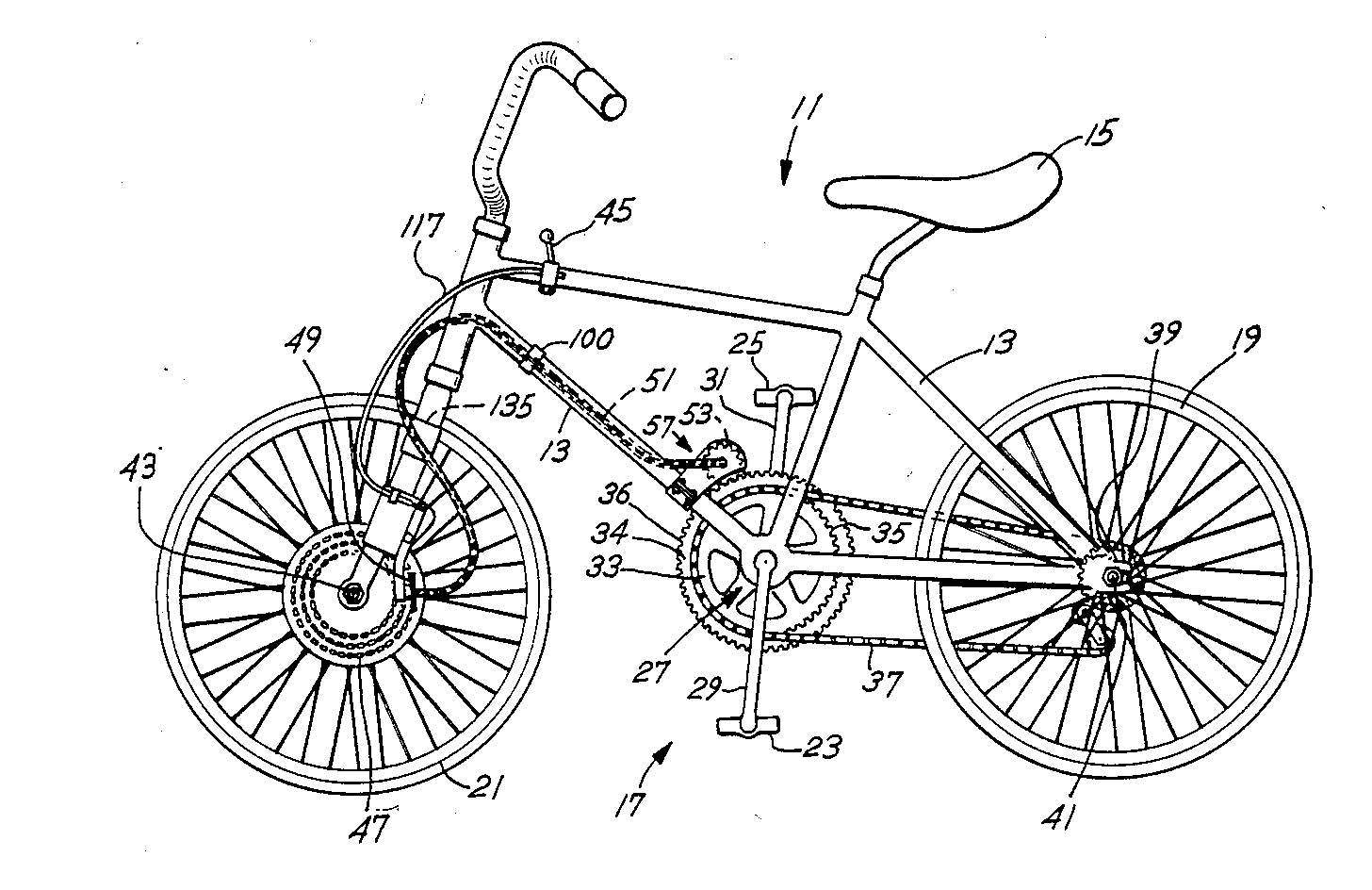
Attention is drawn to the following places, which may be of interest for search:
Arrangement or mounting of control devices for vehicle transmissions for chamging number of driving wheel |
This place covers:
Transmission arrangement in particular for cycles like motorcycle or scooter equipped with two different sources of power, e.g. electric or internal combustion engine, and able to transmit the drive by using both sources alone or together.
This place does not cover:
Transmissions using rider propulsion with additional source of power |
Attention is drawn to the following places, which may be of interest for search:
Motorcycles characterised by position of motor or engine |
This place covers:
Actuators devices operated by hand, e.g. levers, or foot and using mechanical, e.g. cables, electrical or fluid systems. to control the gear speed-change transmission mechanism.
This place does not cover:
Functional aspects of the components per se, e.g. the details of the lever or the handle grip, pedals, or the like
Handle bar grips | |
Twist grips | |
Levers | |
Levers and grips especially adapted for brake mechanism |
However, in many cases documents should be classified in both groups because often show both aspects.
Attention is drawn to the following places, which may be of interest for search:
Transmission characterised by the use of endless belt or the like, the chain, belt or the like being laterally shiftable | |
Rider operated controls for cycles in general |
This place covers:
Mainly snow vehicles with or without engine or motor, e.g. cycles having a endless truck rather than a wheel, or motor-powered sledges.
Two examples are shown in the following figures.
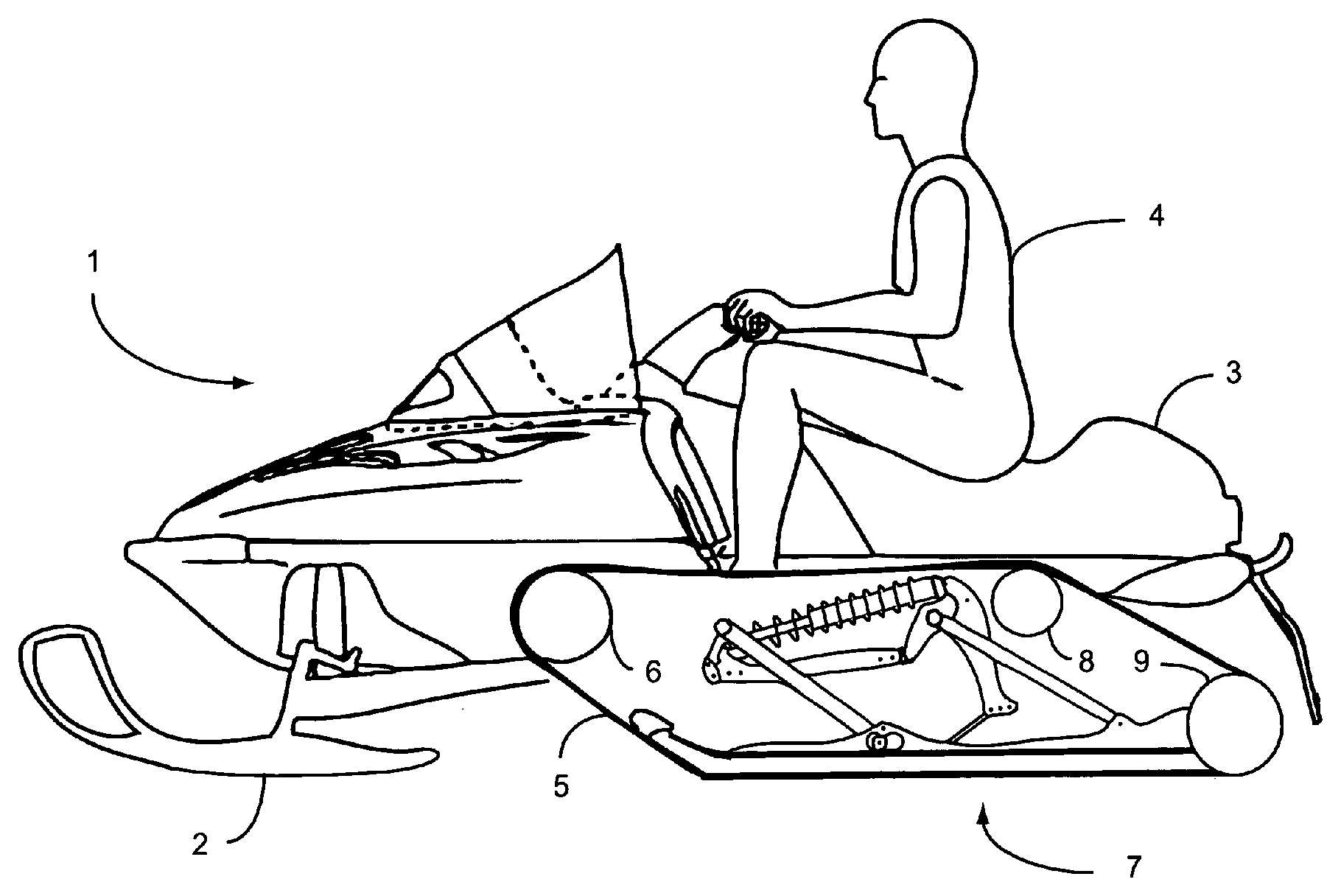
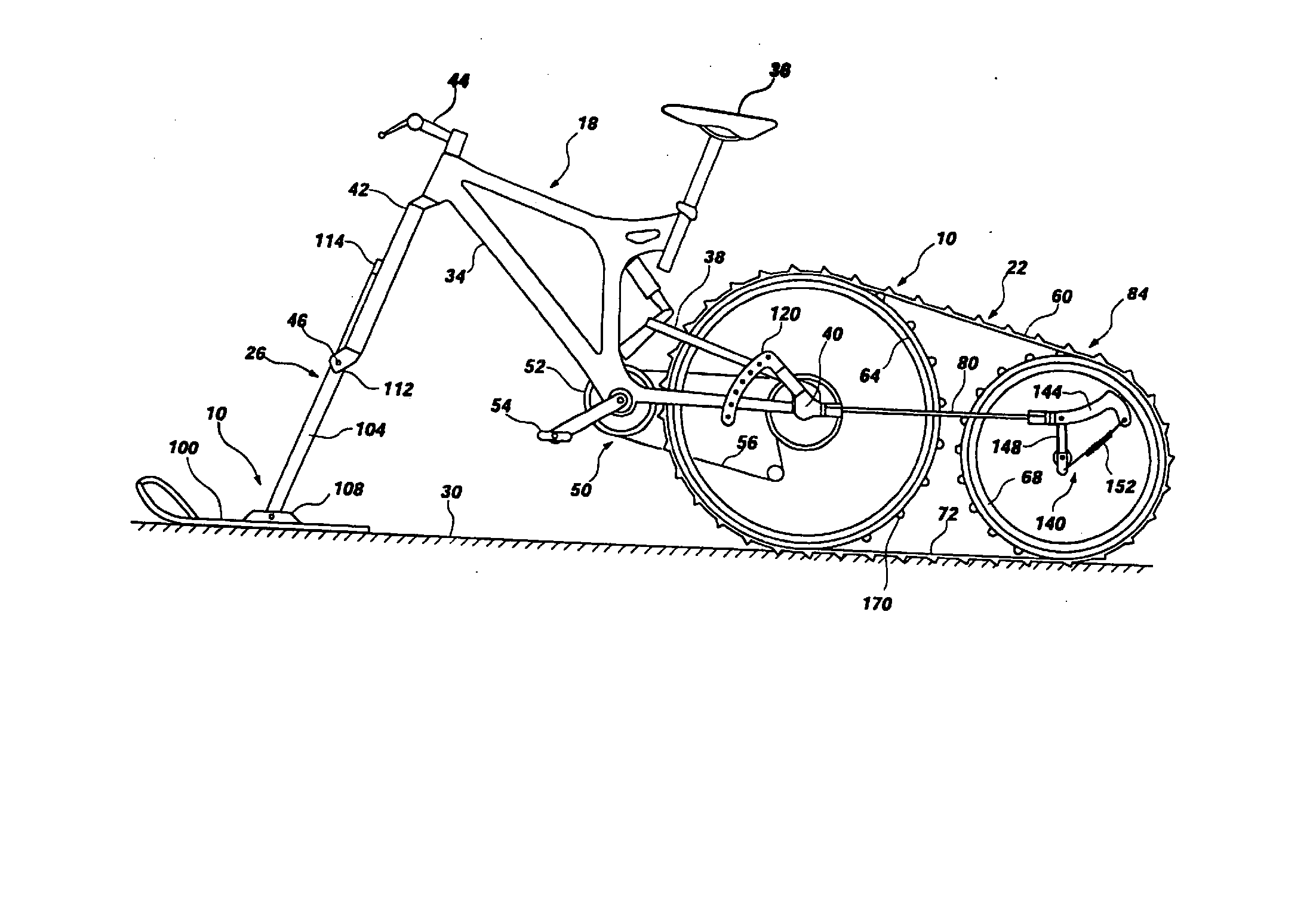
Attention is drawn to the following places, which may be of interest for search:
Ski or snowboards | |
Sledges with runners |
This place covers:
Similar arrangements of B62M 27/00 but with focus on the ground engaging devices for cycles or any other wheeled vehicles not provided for in other groups in B62M.
This place does not cover:
Bicycles without a seat, e.g. non-motorized scooter |
Attention is drawn to the following places, which may be of interest for search:
Rider propulsion of wheeled vehicles |